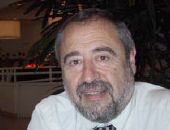|
You are currently
in the Archives section. Please be aware that some information and links
in the archived page may be outdated.
Click here
to return to the Archives' main page to see the list of archived articles.
|
A
R C H I V E S
Where The Hell
is Vitoria?
Don Ricardo Leaves No Doubt
 Ricardo
Gonzalez Placer is more of a transportation professional than most people
that you’ve met. Before launching a career in air cargo development, this
ebullient and engaging Spaniard who hails from Vitoria, a delicious slice
of Basque country located near Bilbao on the southern coast of the Iberian
peninsula, Don Ricardo, was a master seaman who spent more than 17 years
going down to the sea in ships. Ricardo
Gonzalez Placer is more of a transportation professional than most people
that you’ve met. Before launching a career in air cargo development, this
ebullient and engaging Spaniard who hails from Vitoria, a delicious slice
of Basque country located near Bilbao on the southern coast of the Iberian
peninsula, Don Ricardo, was a master seaman who spent more than 17 years
going down to the sea in ships.
For the record, there are two places called
Vitoria that you may or may not know about. One Vitoria is located in
Brazil.
This is about the other Vitoria, the first
one, as mentioned earlier that resides 41km south of Bilbao.
Maybe one reason there is surprise by some
people on hearing of Vitoria as a dynamic and growing air cargo hub is
because up until the 1980’s Vitoria was a sleepy, quiet hamlet.
It was in the early 1980’s that it was chosen
as the headquarters for the Basque region’s government.
The airport of Vitoria-Foronda lies just
5km from the center of the city proper.
Vitoria was founded on the site of a small
hamlet called Gasteiz, perched on the top of a hill.
Sancho el Sabio, king of Navarra and founder
of the city chose Gasteiz as a stronghold against Castille and granted
the town its charter in 1181.
Vitoria continued to grow, protected behind
the city walls. It had three streets which crossed the hill from north
to south, around which the town was laid out in the shape of an almond.
The structure of the medieval town still
remains. In the middle ages, Vitoria was renowned for its craftsmen and
merchants whose guilds gave rise to the names of streets.
At the end of the 18th Century the city
began to expand outside its walls.
During this period the Plaza de Espana was
constructed, marking first expansion to the south.
In the mid-19th century Vitoria expanded
towards the south. This area is now the city center and main shopping
area.
A great place to do business and live in
a cosmopolitan setting, most of the streets and squares in Vitoria are
pedestrianized and contain a large number of sculptures from the Basque
Country.
Vitoria’s city center in fact is very much
an open-air art gallery.
Here you will also find stately mansions,
19th century houses and the new Cathedral.
Calle Paz is the main shopping street of
the city and marks the eastern boundary of the city center.
Vitoria is situated strategically on the
trade routes to most of Southern Europe, Africa and the Middle East.
Vitoria, Spain is where logisticians such
as fast growing DHL and others have set up shop expanding opportunities
in several directions all at once in search of local European and expanding,
emerging international markets.
But Vitoria, Spain (27 years, a venue to
one of the great annual Summer Jazz Festivals) is about to put itself
forward in a major educational and promotional effort toward the Americas.
VIA is busting out all over this June with
a business workshop and what you need to know, vest pocket, right-sized
perishables conference in Miami, Florida.
On June 16-17, VIA brings a relevant, intensive,
and compact learning exercise to the Sofitel in Miami, Florida located
just a stone’s throw away from Miami International Airport’s main runways
where more perishables are transported than at all the other gateways
in North America combined.
Called “Fresh Opportunities II,” the Perishables
Logistics Conference held last year at Vitoria gets a second go around
in Miami.
Good timing and right on subject matter,
make this get together a definite must-to-attend.
Also VIA reaching out to the growing perishables
market in the Americas, offers a new vision and opportunities to Latin
America.
Vitoria International Airport, the air cargo
specialist handled nearly 60,000 tons of cargo during 2002 with more than
60% of that number classified as perishables.
Contact for the event is David Gasull. Phone:
34 945 14 18 00. Fax: 34 945 14 31 56. e-mail: david.via@airvitoria.com.
VIA will also host The International Air
Cargo Association (TIACA) Forum in 2004.
Spain loves seafood. Don Ricardo, who is
the only airport or air cargo executive in the world to hold a master
seaman’s certificate, having plied the seven seas as a full fledged Captain
of great deep water cargo vessels knows a thing or two about trading patterns.
Maybe that’s what makes him so interesting.
More often than not, in his quest to build
VIA, from a specialist all cargo gateway operation into a world class
address for freight, Don Recardo has acted as much as a matchmaker as
anything else.
In the effort to develop trade, Don Ricardo,
just as the MIA conference title implies, uncovers “Fresh Opportunities.”
“I know the airlines,” he says.
“They have no problem going to where the
air cargo is.”
If you get the feeling from those words
that this is one executive who is not content to sit back and wait for
a situation to bite him on the fanny, you are exactly right.
“Based on my years of shipping cargo , I
look to uncover situations and various combinations that can both benefit
from air speed and utilize our gateway as part of the process.
“In any case everything for the shipper,
carrier and gateway has to make sense to develop any kind of a long term
business relationship.
“Not that everything has to work at once.
I believe in solid foundation and complete connectivity between all parties.
The key ingredient in air cargo today is total information. The best surprise
is no surprise.
“Everybody needs to know what to expect.
“Anybody using our gateway has my personal
cell-phone number with the proviso that either myself or somebody standing
in for me is available 24/7 for any situation that might arise.
“Vitoria, (one T and not Victoria, Don Ricardo
insists) is wide open to new business and a place where attitude replaces
altitude in an atmosphere that success aloft begins on the ground at a
place quite capable of handling just about anything.
 “Our
business is developing in what might be viewed as unlikely places such
as Africa and elsewhere, but these are areas that I know from prior experience
can accelerate their growth utilizing air cargo.” “Our
business is developing in what might be viewed as unlikely places such
as Africa and elsewhere, but these are areas that I know from prior experience
can accelerate their growth utilizing air cargo.”
Servicios Logisticos y de Handling, Decoexsa,
was the first private Spanish company to set up business at Vitoria Airport
with the construction of a modern perishables terminal.
Right now the perishables set up at VIA
is the second largest of its type in Europe.
The constant transport development of perishables
through Vitoria Airport has allowed thousands of tons of various products
including a growing variety of live animals to pass through the gateway
from countries such as South Africa, the United States, Canada, Chile,
Brazil, Argentina and Mexico.
From nowhere just a few years ago, VIA is
evolving into a major trans-shipment center in southern Europe traffic
patterns.
Built upon professionalism from the ground
up, at VIA a highly qualified team of personnel specializes in the extremely
demanding and precise logistics involved in the transport of perishables.
At VIA the process is perfectly coordinated
with on the spot efficient customs and health services .
These and other competitive advantages of
the airport, allow a turnaround time of 2 hours from the moment the goods
arrive by plane to the time they are delivered to the consignees.
From VIA an extensive road-feeder network
fans out from the Basque country to points all over Europe.
By truck, goods can be delivered to the
main Central European marketplaces in 12 hours or less.
These shipping times, unprecedented in this
sector, mean that perishables from field to table arrive in optimum condition
with less spoilage.
Greater value in getting goods to market,
enables efficient and profitable operation only available from a specialist.
“Call it niche marketing or specialized
handling but the fact is, that the VIA perishables alternative to and
from other gateways affords even the small shipper an opportunity to be
a “big fish” here with all the collateral attention in getting goods to
market that the name implies.”
At VIA, DECOEXSA carries out customs clearance
duties around the clock seven days a week.
The company manages the live animal operation
at the airport and offers importers and exporters comprehensive logistics
services, including transport and tracking in special refrigerated trucks
to the whole of Europe.
The DECOEXSA terminal has the following
characteristics:
9,500 m2 dedicated to perishable products;
4,000 m2 of temperature-controlled warehouses; 3,500 m2 car park, 900
m2 for the assembly and disassembly of pallet platforms plus 500 m2 of
fully computerized administrative offices.
The DECOEXSA operation also includes 240
m2 for making trays both inside and in the open air; 16 roller ways with
156 positions for aircraft loading trays, 9 bays for loading trucks (1,500
m2), 6 air side doors and 6 refrigeration chambers.
Operability, intermodality and first-class
aeronautical infrastructure offered by Vitoria Airport to companies specializing
in integrated services, has attracted two large international companies
who have set up part of their strategic operations in Europe at VIA.
Integrators EAT-DHL and TNT and Perishables
specialist (DECOEXSA), who also provide general cargo services, are joined
by Iberia, the Spanish flag airline, with a cargo handling operation at
VIA from which it offers ramp and terminal handling service for all kinds
of goods.
Iberia’s team in Vitoria operates the machinery
required to unload big all-cargo aircraft.
Two lifting platforms with a capacity of
11,000 kg, plus one lifting platform for 3,600 kg. are part of the total
ground support package offered by IB at VIA.
“We recognize that business is challenged
right now with operators needing to receive every possible return on investment
of time and resources. But there are also opportunities for those companies
who will just take the time to continue their search for new business.
“The VIA advantage is real and ready for
those who are focused on the future.”
|

Boeing
needs to sell airplanes, so it figures it has to do something.
Right now, about the last thing anybody wants
to talk about is buying an airplane.
Put another way, while aircraft fill the desert
as far as the eye can see , like some kind of mirage, each one costs a king’s
ransom to keep.
But with idle aircraft offering little or
no return, the airline nightmare of 2003 continues.
About the only thing the airplane salesman
has right now in addition to the ability to build more airplanes, is to
loosen up the public by ratcheting up some excitement about aviation.
So here comes Boeing with a marketing alliance
that will engage people from around the world in the development of its
new wannabe airplane called for now the Boeing 7E7. The Boeing 7E7 which
exists in the world right now as an idea, a movement within the Boeing company,
and lots of drawings, money spent, and hope is the airplane manufacturer’s
dream to sell what it calls “a super-efficient”, mid-sized airplane that
is expected to enter service in 2008î.
So Boeing and AOL Time Warner make this deal
to preview the B-7E7 online and offline with initiatives designed to engage
consumers in the development of the proposed new airplane.
 Mike Blair
Mike Blair |
Kicking
off next month, AOL members will have exclusive online access to a 360-degree
animated tour of the B7E7 for 30 days before it is available to the general
public.
B7E7 is viewed as part of AOL “100 Years of
Flight” (AOL Keyword: 100 Years of Flight).
AOL’s “100 Years of Flight” celebration also
offers a retrospective photo gallery showing highlights from the past 100
years of aviation.
“Name Your Plane” will afford web geeks the
opportunity to select from four possibilities for the name of the hoped
for Boeing B7E7 plane Dreamliner, eLiner, Global Cruiser and Stratoclimber.
Votes can be placed through AOL (AOL Keyword:
Boeing) or on the World Wide Web at www.newairplane.com
or www.timeforkids.com
AOL members and non-members in China, France,
Germany, Japan, the United Kingdom and the United States can also participate
in a sweepstakes to win prizes.
Rob Pollack, vice president of Branding for
Boeing Commercial Airplanes Marketing, said the new marketing approach and
alliance with AOL Time Warner opens up a whole new world of opportunity
for Boeing to understand the priorities and needs of the flying public.
“You can expect to see a whole new approach
to how we tell the world about the airplane and encourage participation
and feedback in the work we are doing,” Pollack said.
“We are looking at our new airplane as an
opportunity to change the way we do business.”
Naming the airplane is just the first step
of involvement for those who volunteer to be part of the World Design Team,
a virtual community that those who go to the sweepstakes site will be able
to join.
Members of the team will be provided with
future opportunities to participate in the development of the Boeing 7E7,
including surveys concerning design elements and sneak peeks as the design
of the exterior and interior evolves.
The 7E7 Boeing said will carry 200-250 passengers
on routes between 7,200 and 8,000 nautical miles (13,334-14,816 km).
In addition to bringing big-jet ranges to
mid-size airplanes, Boeing assures that the new airplane will provide airlines
with unmatched fuel efficiency, resulting in exceptional environmental performance.
“The airplane will use 15 to 20 percent less
fuel for comparable missions than any other wide body airplane.
“The B7E7 will also travel at speeds similar
to today’s fastest wide bodies, about Mach 0.85.”
Boeing hopes to offer the airplane late this
year (2003), with first firm offers being made to airlines in early 2004.
Production is slated begin in 2005. First
flight is expected in 2007 with certification, delivery and entry into service
occurring in 2008.
Mike Blair 46, is senior vice president of
the Boeing 7E7 program. Mr. Blair who headed up Boeing’s Sonic Cruiser send-up
is now in charge of all aspects of the development effort.
When you think about it both Boeing and Airbus
are doing just what the airline business needs right now, they are developing
and disseminating to the masses what’s next in air travel.
Sure as mentioned, aircraft are parked a-plenty,
but what drives commercial aviation into its unlimited future is excitement
and discovery, and of course, peace on earth.
The B7E7 offering edge technologies developed
for Sonic Cruiser, plus other benefits of Boeing’s superb B777 program,
in a smaller airplane, should be a big winner.
Likewise, Airbus A380, that will capture the
blue-ribbon as the world’s newest, biggest super-jumbo and queen of the
skies, will draw into air transportation vast numbers of people the world
over.
While it is uncomfortably easy to worry about
our industry right now, it is also right and a good thing to dream a little
bit about tomorrow.
Which is exactly how the Wright Brothers and
others got flight going in the first place. |

